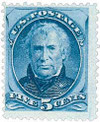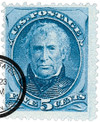
# 185 - 1879 5c Zachary Taylor, blue
1879 5¢ Taylor
American Bank Note Printing
Earliest Known Use: January 15, 1879
Quantity issued: 42,000,000 (estimate)
Printed by: American Bank Note Company
Method: Flat plate
Watermark: None
Perforation: 12
Color: Blue
Siege Of Veracruz
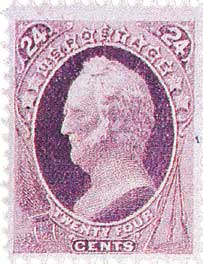
On March 9, 1847, the US launched its first large-scale amphibious assault during the Siege of Veracruz.
The battle was part of the Mexican-American War, which began in May 1846. The war largely stemmed from the US annexation of Texas and the Texan border. Major General Zachary Taylor led US forces in a string of victories at Palo Alto, Resaca de la Palma, and Monterrey.
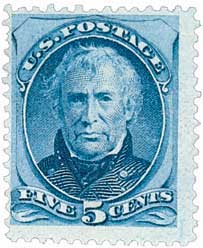
After capturing Monterrey in a bloody battle, Taylor gave the Mexican defenders an eight-week armistice, during which time they went free. Back in Washington, President James K. Polk was angry over this and began discussing the next stage in the US strategy. His military advisors ultimately decided that attacking the capital at Mexico City would be the best way to win the war. But marching troops 500 miles from Monterrey would be impractical. Instead, they decided the best plan of action would be to land troops on the coast near Veracruz and march to the capital.
Polk considered placing Taylor in charge of the siege, but Taylor had spoken out against him in the past. Instead, he chose Major General Winfield Scott. The majority of Taylor’s troops would leave to join the siege at Veracruz. Meanwhile, Taylor and a small army remained behind and defeated a much larger Mexican force at the Battle of Buena Vista.
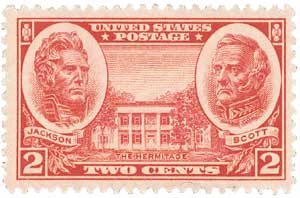
Scott reached Lobos Island, fifty miles from Veracruz, on February 21, 1847. Over several days, the men from Monterrey arrived and by March 2, he had about 10,000 men ready to fight. They boarded ships for Veracruz on March 7.
Veracruz was considered the most heavily fortified city in the Western Hemisphere – surrounded by walls, guarded by three forts and 128 guns. To avoid these guns, Scott chose to land his forces to the southeast at Mocambo Bay’s Collado Beach. About 1:00 pm on March 9, 1847, American troops in specially designed surfboats made their way to the shore. Only a small number of Mexican defenders were present and they were quickly chased off. The first group of 5,500 men stepped ashore with no opposition, so Scott called in the rest of his force and they began moving toward the city.
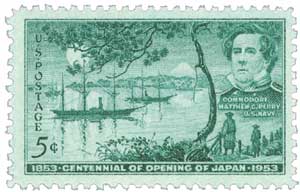
North of the beachhead, one brigade beat a group of Mexican cavalry and cut the road to Alvarado as well as the city’s water supply. Meanwhile, the rest of the forces circled Veracruz and the city was completely surrounded within three days. Within the city, there were 3,360 defenders. The Mexican commander hoped to hold the city until more men could arrive.
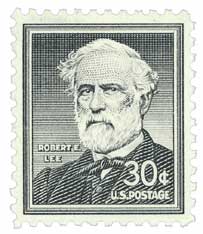
In the meantime, Robert E. Lee, Joseph Johnston, and George McClellan set up gun emplacements and strengthened the siege lines. On March 21, Commodore Matthew Perry arrived and offered six naval guns and their crews. The following day, Scott demanded the city’s surrender. When they refused, he ordered the bombing to begin.
The bombing continued for several days, during which time the Mexican commanders twice asked for a ceasefire. Scott believed it was a delaying tactic and refused the first request. Then on March 26, he agreed to surrender negotiations. In addition to capturing the city, Scott had done so with few American casualties – 13 killed and 54 wounded. With Veracruz secure, Scott went on to capture Mexico City.
1879 5¢ Taylor
American Bank Note Printing
Earliest Known Use: January 15, 1879
Quantity issued: 42,000,000 (estimate)
Printed by: American Bank Note Company
Method: Flat plate
Watermark: None
Perforation: 12
Color: Blue
Siege Of Veracruz

On March 9, 1847, the US launched its first large-scale amphibious assault during the Siege of Veracruz.
The battle was part of the Mexican-American War, which began in May 1846. The war largely stemmed from the US annexation of Texas and the Texan border. Major General Zachary Taylor led US forces in a string of victories at Palo Alto, Resaca de la Palma, and Monterrey.

After capturing Monterrey in a bloody battle, Taylor gave the Mexican defenders an eight-week armistice, during which time they went free. Back in Washington, President James K. Polk was angry over this and began discussing the next stage in the US strategy. His military advisors ultimately decided that attacking the capital at Mexico City would be the best way to win the war. But marching troops 500 miles from Monterrey would be impractical. Instead, they decided the best plan of action would be to land troops on the coast near Veracruz and march to the capital.
Polk considered placing Taylor in charge of the siege, but Taylor had spoken out against him in the past. Instead, he chose Major General Winfield Scott. The majority of Taylor’s troops would leave to join the siege at Veracruz. Meanwhile, Taylor and a small army remained behind and defeated a much larger Mexican force at the Battle of Buena Vista.

Scott reached Lobos Island, fifty miles from Veracruz, on February 21, 1847. Over several days, the men from Monterrey arrived and by March 2, he had about 10,000 men ready to fight. They boarded ships for Veracruz on March 7.
Veracruz was considered the most heavily fortified city in the Western Hemisphere – surrounded by walls, guarded by three forts and 128 guns. To avoid these guns, Scott chose to land his forces to the southeast at Mocambo Bay’s Collado Beach. About 1:00 pm on March 9, 1847, American troops in specially designed surfboats made their way to the shore. Only a small number of Mexican defenders were present and they were quickly chased off. The first group of 5,500 men stepped ashore with no opposition, so Scott called in the rest of his force and they began moving toward the city.

North of the beachhead, one brigade beat a group of Mexican cavalry and cut the road to Alvarado as well as the city’s water supply. Meanwhile, the rest of the forces circled Veracruz and the city was completely surrounded within three days. Within the city, there were 3,360 defenders. The Mexican commander hoped to hold the city until more men could arrive.

In the meantime, Robert E. Lee, Joseph Johnston, and George McClellan set up gun emplacements and strengthened the siege lines. On March 21, Commodore Matthew Perry arrived and offered six naval guns and their crews. The following day, Scott demanded the city’s surrender. When they refused, he ordered the bombing to begin.
The bombing continued for several days, during which time the Mexican commanders twice asked for a ceasefire. Scott believed it was a delaying tactic and refused the first request. Then on March 26, he agreed to surrender negotiations. In addition to capturing the city, Scott had done so with few American casualties – 13 killed and 54 wounded. With Veracruz secure, Scott went on to capture Mexico City.



